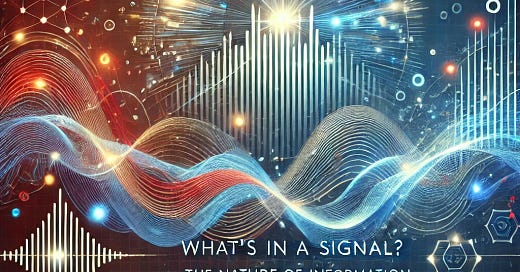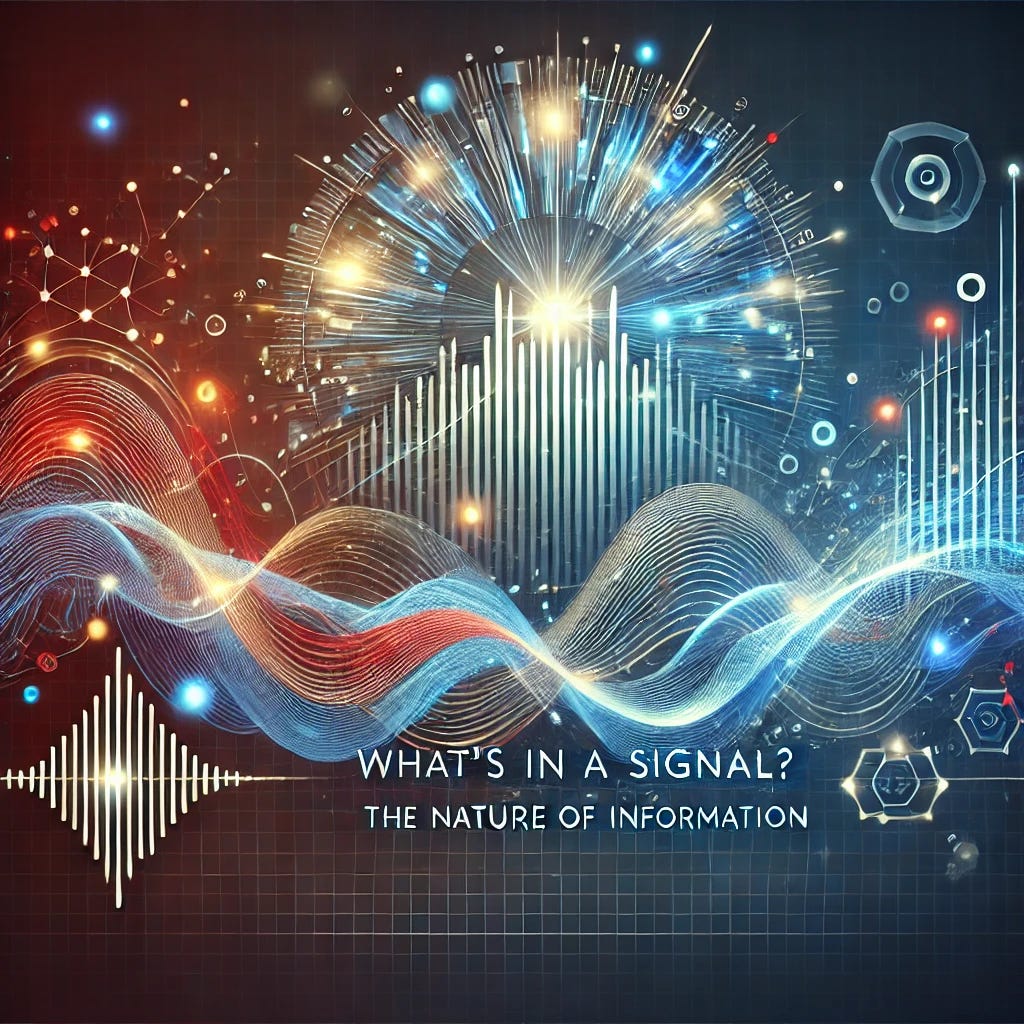Welcome to MetaMind. Let’s unlock the power of context—together.
Welcome back to MetaMind, where we unravel the hidden layers of intelligence. Today, we begin at the very beginning—the foundation of it all: What’s in a signal?
Every day, whether you realize it or not, you’re surrounded by signals. A text message, a song on the radio, a snippet of conversation overheard in a café. But what makes these signals meaningful? And what distinguishes a signal from noise? To understand intelligence—whether human or artificial—first, we must understand the nature of information.
Let’s start with a thought experiment. Imagine you’re standing on a darkened street corner at night, trying to communicate with a friend 50 meters away. You have no phone, no way to speak, no visible gestures. Just a flashlight. Now, you flash it once. Then twice. Then, you pause for a few seconds, and flash it three more times. Is there meaning in these flashes?
The answer is… it depends. Without an agreed-upon system or context, the pattern is just a series of blinks in the dark—noise. But, if you both agreed beforehand that one flash means ‘I’m here,’ two flashes mean ‘I’m okay,’ and three flashes mean ‘come quickly,’ those same signals transform into meaningful information.
What is a Signal?
A signal is any action or message that transmits data from a sender to a receiver. It can be a flash of light, a sequence of sounds, a stream of bits in a computer… but it’s the structure of that signal that makes it meaningful—or not. In essence, a signal is anything that reduces uncertainty. Let’s look at the simplest example: a coin flip.
If I say I’m about to flip a coin, there’s uncertainty—two possibilities, heads or tails. When I reveal that the outcome is ‘heads,’ I’ve transmitted information. I’ve resolved that uncertainty. This is where Claude Shannon, the father of information theory, came in.
Claude Shannon and the Birth of Information Theory
In the 1940s, Shannon proposed a radical new way of thinking about communication. He showed that information could be measured mathematically, just like physical properties such as weight or speed. His breakthrough was to quantify how much information a signal contains based on its ability to reduce uncertainty—what he called entropy.
Imagine a long text message filled with repeated words and phrases—something like ‘I’m fine, I’m fine, I’m fine…’. It has low information content, because it’s predictable, and thus reduces very little uncertainty. But now imagine a message filled with unique words and complex ideas—it’s dense, unpredictable, and carries high information content. That’s what Shannon meant by entropy: the measure of uncertainty or surprise in a message.
Let’s take this a step further. Consider language itself. If I say the sentence, ‘The quick brown fox jumps over the…,’ your brain automatically fills in the word ‘lazy dog,’ right? This is because English is a redundant language—certain patterns occur frequently, making some outcomes more predictable than others. Redundancy is useful for reducing errors, but it also lowers the amount of raw information.
Signal vs. Noise—Finding Meaning in Complexity
Now, let’s introduce a critical distinction: signal versus noise. Signal is any part of the message that adds meaning; noise is anything that disrupts or obscures that meaning. Consider listening to someone speak in a crowded café—the words are the signal, while the background chatter is the noise.
But what happens when noise itself looks like a signal? This is where the challenge of modern communication comes in. Think of an email filled with random letters or a message that’s been corrupted by bad reception. Without structure, these garbled signals carry no meaning.
Today’s AI systems face a similar challenge. They must separate the meaningful patterns from the noise, whether in voice recognition, visual processing, or complex data analysis. And this brings us to the role of context, which we’ll explore further in the next episode.
Teasing the Role of Metadata
We’ve seen how a signal’s structure and entropy shape its meaning—but this is only part of the story. What happens when we add a layer of context? This is where metadata comes into play, acting as a lens that reinterprets the signal based on additional information. Think of metadata as the decoder ring that tells you how to read the message.
In the coming episodes, we’ll dive into how metadata transforms simple signals into sophisticated networks of meaning, enabling AI to recognize patterns, make predictions, and—perhaps—begin to understand.
Final Thoughts
Next time, we’ll look at the power of context—how metadata shapes what’s seen, what’s ignored, and how even a small shift in meaning can change the entire signal. Join me for Episode 2: ‘From Data to Meaning: Context and the Power of Perspective.’ Until then, remember—every signal, no matter how small, carries a hidden story, waiting to be decoded.














Share this post